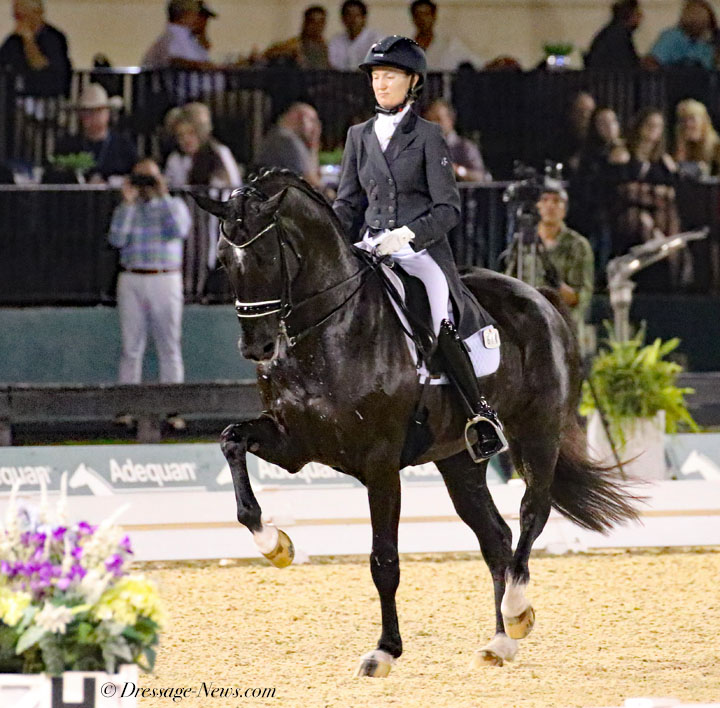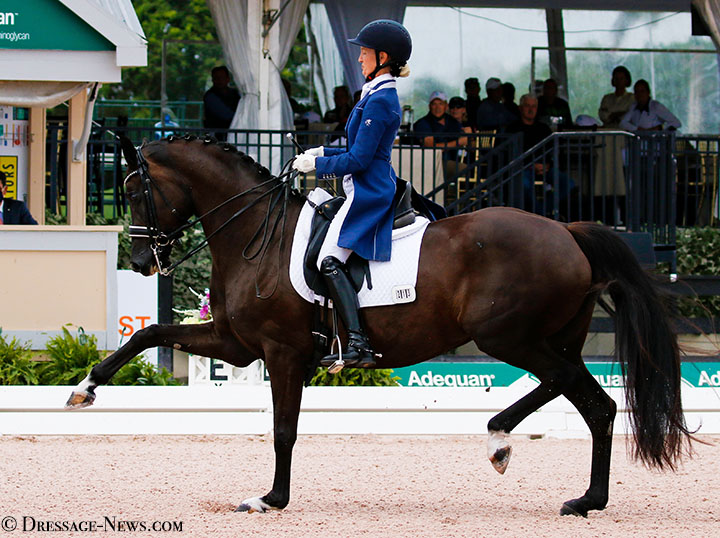Alice Tarjan With Record Number of Horses at USA Festival of Champions, Ahead of Aachen, Germany for Rider’s First European Show
4 years ago StraightArrow Comments Off on Alice Tarjan With Record Number of Horses at USA Festival of Champions, Ahead of Aachen, Germany for Rider’s First European Show

Aug. 25, 2021
By KENNETH J. BRADDICK
Alice Tarjan, with a record nine horses in the U.S. Festival of Champions this week, is scheduled to compete next month in her first ever European event, at Big Tour at the World Equestrian Festival in Aachen, Germany, the globe’s most prestigious horse show.
In the CDI4* at Aachen Sept. 14-19, Alice will ride Candescent, the 11-year-old black Hanoverian mare on which she placed sixth in the U.S. Olympic team observation event from which the team of three and a reserve were selected for the Tokyo Games to earn an historic team silver medal.
Alice of Oldwick, New Jersey will compete both Candescent and Donatella M in the Grand Prix championship at Wayne, a Chicago suburb, this week. She won the U.S. Developing Grand Prix title on Donatella in 2020 and was runner-up on Harvest which she will show along with the American-bred Serenade MF in developing Grand Prix this year. She will compete Summersby in the six-year-old division, Gjenganger in the five-year-old and Ierland’s Eden in the four-year-old. Marcus Orlob, her coach, will ride Glory Day in the five-year-old and Maximus in the four-year-old divisions. Both horses are owned by Alice.
She has been a competitor for several years at the Festival of Champions, a conglomeration of championships for children and ponies up to Grand Prix as well as young horse divisions, as she has developed horses bought as youngsters from videos.
Aachen, a century-old tournament that showcases top dressage, jumping, eventing, driving and vaulting, was not on the radar for Alice, 42, but says she was talked into it by Charlotte Bredahl, the U.S. developing coach, and Marcus Orlob.
“I’m terrified,” she half-joked to dressage-news.com. ” It’s one thing to run your horses around your backyard, and it’s another thing to go to a horse show, and it’s like a whole other thing to go to Europe. It’s a whole different league that I don’t belong in. I think it’s a crazy idea but I got outvoted on this one so I’m just following orders.”
Candescent is the first of the four horses she is competing at the festival that she has developed to or near Grand Prix with more in the pipeline that could fulfill her goal of a lineup similar to top European riders. She points to Americans Laura Graves and Sabine Schut-Kery as doing what the sport means to her, successfully training young horses up to to top sport.

As a kid, Alice rode a $500 off-the-track Thoroughbred and whatever anyone would let her ride for free because that’s all she could do. It was sometimes “a disaster,” she recalls, often landing in the dirt but, “I got hours and hours on horseback so you get a really good sense of horses and how they react and about feel. I think that can translate into how to train a horse.”
A serious health issue became a turning point when she was fresh out of law school and battling cancer 15 years ago. She had just enough money to buy a foal that she desperately wanted to grow up enough to compete in what she feared was a race against time.
Over time with her health restored, she kept aquiring horses, buying from videos–up to 12 warmbloods, plus a P.R.E., in her barn now–leading to what used to be a joke: “We’ve got a bunch of young horses, but just wait and we’ll have a whole barn full of Grand Prix horses. If I can do it, why not?”
Along the way, she has developed a training program that is unusual, but suits her style of do-it-yourself with help from Marcus Orlob who is based in New Jersey and from Lars Petersen, the Olympian who rode for Denmark but now for the USA and is based near where she operates in Florida during winter. More recently she has had strong support from Charlotte Bredahl.
“The more horses you’ve trained the better you get,” she said, “the more different ideas you get from each horse. When you start with your first horse you’re out there sort of in the swamp. You don’t know which direction to go in. The more you do it you have a better idea and more confidence to go into the swamp and pull things out of it than in the beginning when it was scary.”
Many of her horses are black and typically have big gaits that require skill to make it appear harmonious in the show ring. That can also lead to horses being stressed physically.
“You read it and you hear it,” she said, “you’re going to work the hardest and you’re going to win. I’m going to go out there and work harder than anyone else and I’m going to train my horses five days a week religiously Monday through Friday.
“I found out that you can’t train horses that move like that hard five days a week. Some stay sound but not all of them. And I looked at my barn and my friends’ barns and I thought. ‘they don’t have horses that have the kind of problems my horses are having.’ Clearly my program was the problem.
“If you want your horses to move big like mine do you have to find a way to keep them sound. I moved them down to a four days a week. I decided to get aggressive because I want my horses to stay sound. So I moved them down to three days a week. I’ll take sounder in the long run any day.
“The Grand Prix horses work Monday, Wednesday and Friday. They are never going back to back. The younger horses I may do Monday, Tuesday, Thursday. But I never do three days in a row with the horses. The other two days they go hacking around the hills, and they get two days off.
“They stay sound. And they train up fine. I don’t feel that by cutting back their training I can’t get them trained in time. I’ve got a seven-year-old right now and she’s going to be ready for the Grand Prix next year. If they’re doing Grand Prix at eight you can’t say they’re not being trained fast enough. So I figure if I can do the same job in three days a week instead of five and they stay sound that’s a good thing.
“If they don’t stay sound it slows you down. If you’ve got a horse that’s injured you’ve got six months off and then rehab and that slows you down. It’s much better to keep them sound consistently and try to be smart about it.

“I also think that I’m going to have my horse a lot longer because it’s sound its whole life, it doesn’t have any injuries. If it takes me a year longer to make the horse more confirmed so be it. Some people probably think I’m nuts but it works for me.”
Alice tends not to set goals that may not be right for the horses, such as whether she will have a horse to compete on the American team for the world championships in Europe next year.
“I think you train the horses and you show them and the scores tell you where you end up, right? I think it’s very simple. I don’t think it matters where I want to aim them or not. I don’t think it makes any difference. I’m trying to be very realistic.
“All I can do is go out there and train those horses to the best of my ability and to put them in the ring and whatever scores they get then those are the scores. The scores are going to dictate what happens or not. If I can go out and pull a high 70s then I may have a shot at the (world championships). If I go out there and get 72 that’s great. I’ll be happy, and that’s fine, too.
“All I can say is I know how to keep my horses happy and sound and continue to train them and put them in the ring and see where it lands.”

